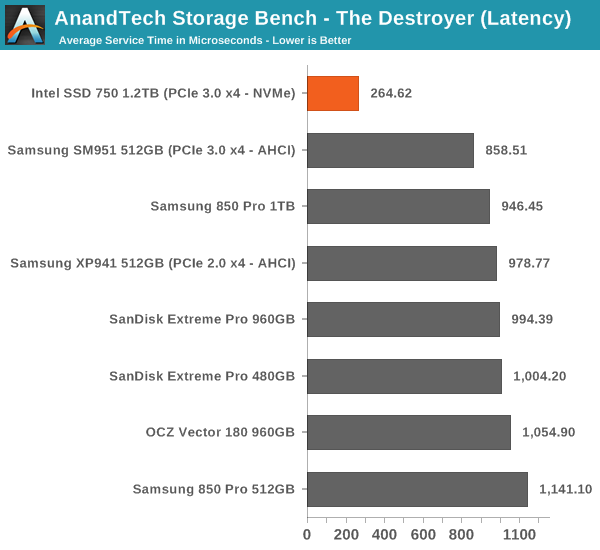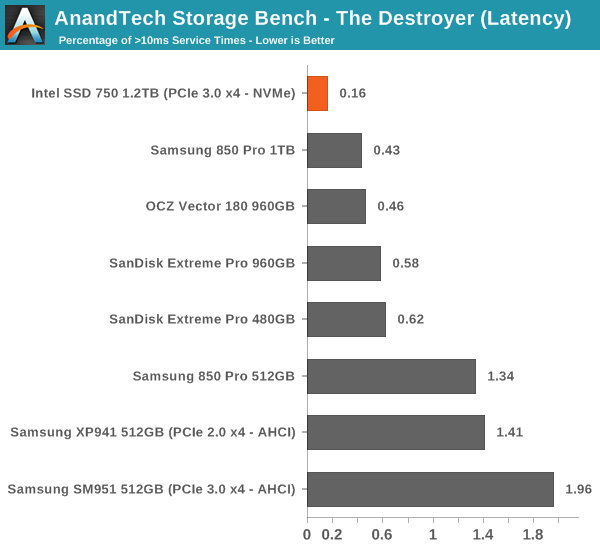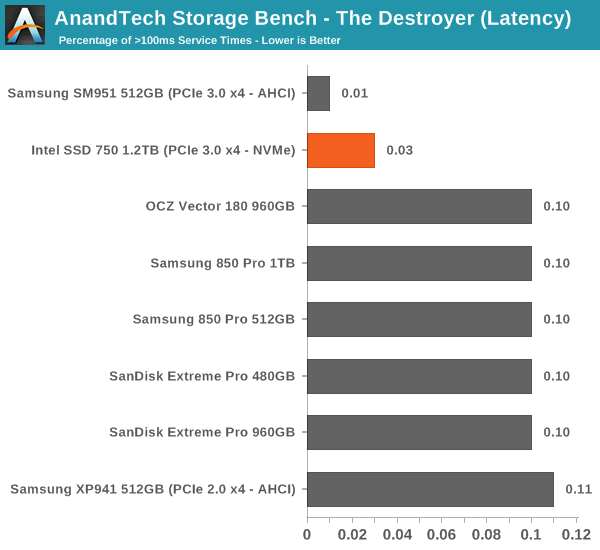Intel SSD 750 PCIe SSD Review: NVMe for the Client
by Kristian Vättö on April 2, 2015 12:00 PM ESTAnandTech Storage Bench - The Destroyer
The Destroyer has been an essential part of our SSD test suite for nearly two years now. It was crafted to provide a benchmark for very IO intensive workloads, which is where you most often notice the difference between drives. It's not necessarily the most relevant test to an average user, but for anyone with a heavier IO workload The Destroyer should do a good job at characterizing performance.
| AnandTech Storage Bench - The Destroyer | ||||||||||||
| Workload | Description | Applications Used | ||||||||||
| Photo Sync/Editing | Import images, edit, export | Adobe Photoshop CS6, Adobe Lightroom 4, Dropbox | ||||||||||
| Gaming | Download/install games, play games | Steam, Deus Ex, Skyrim, Starcraft 2, BioShock Infinite | ||||||||||
| Virtualization | Run/manage VM, use general apps inside VM | VirtualBox | ||||||||||
| General Productivity | Browse the web, manage local email, copy files, encrypt/decrypt files, backup system, download content, virus/malware scan | Chrome, IE10, Outlook, Windows 8, AxCrypt, uTorrent, AdAware | ||||||||||
| Video Playback | Copy and watch movies | Windows 8 | ||||||||||
| Application Development | Compile projects, check out code, download code samples | Visual Studio 2012 | ||||||||||
The table above describes the workloads of The Destroyer in a bit more detail. Most of the workloads are run independently in the trace, but obviously there are various operations (such as backups) in the background.
| AnandTech Storage Bench - The Destroyer - Specs | ||||||||||||
| Reads | 38.83 million | |||||||||||
| Writes | 10.98 million | |||||||||||
| Total IO Operations | 49.8 million | |||||||||||
| Total GB Read | 1583.02 GB | |||||||||||
| Total GB Written | 875.62 GB | |||||||||||
| Average Queue Depth | ~5.5 | |||||||||||
| Focus | Worst case multitasking, IO consistency | |||||||||||
The name Destroyer comes from the sheer fact that the trace contains nearly 50 million IO operations. That's enough IO operations to effectively put the drive into steady-state and give an idea of the performance in worst case multitasking scenarios. About 67% of the IOs are sequential in nature with the rest ranging from pseudo-random to fully random.
| AnandTech Storage Bench - The Destroyer - IO Breakdown | |||||||||||
| IO Size | <4KB | 4KB | 8KB | 16KB | 32KB | 64KB | 128KB | ||||
| % of Total | 6.0% | 26.2% | 3.1% | 2.4% | 1.7% | 38.4% | 18.0% | ||||
I've included a breakdown of the IOs in the table above, which accounts for 95.8% of total IOs in the trace. The leftover IO sizes are relatively rare in between sizes that don't have a significant (>1%) share on their own. Over a half of the transfers are large IOs with one fourth being 4KB in size.
| AnandTech Storage Bench - The Destroyer - QD Breakdown | ||||||||||||
| Queue Depth | 1 | 2 | 3 | 4-5 | 6-10 | 11-20 | 21-32 | >32 | ||||
| % of Total | 50.0% | 21.9% | 4.1% | 5.7% | 8.8% | 6.0% | 2.1% | 1.4% | ||||
Despite the average queue depth of 5.5, a half of the IOs happen at queue depth of one and scenarios where the queue depths is higher than 10 are rather infrequent.
The two key metrics I'm reporting haven't changed and I'll continue to report both data rate and latency because the two have slightly different focuses. Data rate measures the speed of the data transfer, so it emphasizes large IOs that simply account for a much larger share when looking at the total amount of data. Latency, on the other hand, ignores the IO size, so all IOs are given the same weight in the calculation. Both metrics are useful, although in terms of system responsiveness I think the latency is more critical. As a result, I'm also reporting two new stats that provide us a very good insight to high latency IOs by reporting the share of >10ms and >100ms IOs as a percentage of the total.

In terms of throughput, the SSD 750 is actually marginally slower than the SM951, although when you look at latency the SD 750 wins by a large margin. The difference in these scores is explained by Intel's focus on random performance as Intel specifically optimized the firmware for high random IO performance, which does have some impact on the sequential performance. As I've explained above, data rate has more emphasis on large IO size transfers, whereas latency treats all IOs the same regardless of their size.

The number of high latency IOs is also excellent and in fact the best we have tested. The SSD 750 is without a doubt a very consistent drive.












132 Comments
View All Comments
oranos - Friday, April 3, 2015 - link
Insane performance, insane value. What else to say? Intel never loses a step and surprises at every turn.Peichen - Friday, April 3, 2015 - link
Sounds like there is going to be big form factor change coming to desktop computer in the next few years. Complete removal of 5.25 and 3.5" drives, M.2 and 2.5" drives taking over, CPU limted to <77W and video card to <250W.I should hold off replacing my still very good case until I am building a new computer in 3~4 years.
cjones13 - Friday, April 3, 2015 - link
how would this drive compare with a 4 drive (samsung 850 pro 512), two card Sonnet tempo ssd pro plus arrangement? this set up is about $600 more, but 800GB larger and overall ~same $/GB @.82Freakie - Friday, April 3, 2015 - link
Maybe I'm just blind, but I don't see this 750 in Bench? Did someone forget to add it to Bench or is there a reason why it's not in there?boe - Saturday, April 4, 2015 - link
Those 10TB and 32TB SSDs can't come soon enough. I just hope they come down to an affordable price very soon as standard SSDs are still way to expensive per TB for any real storage needs.gattberserk - Saturday, April 4, 2015 - link
Can I ask why is the boot time so slow? For a drive this expensive this is not something that is tolerable.Is it possible to do a boot up timing with the fast boost function enabled? I wanna see how fast will it be as compared with other SATA drives using the same fast boot function.
The boot up time will be the last factor to decide if I wanna pull trigger on this one.
Laststop311 - Saturday, April 4, 2015 - link
This drive is a beast and just raised the cost of my skylake-e build another 1000 dollars. Maybe an even better 2nd generation version will be out by then. Upgrading my gulftown to 8 core skylake-e flagship. 4.3ghz i7-980x will have lasted me 7 years by the time skylake-e comes out which is a pretty darn good service life. Convert the ole gulftown into a seedbox/personal cloud nas/htpc/living room gaming console. Kill all the oc's and undervolt cpu for the lowest voltage stable at stock and turn all the noctua fans down with ULN adapters into silence mode. It will be rough re buying a buncha parts I wouldn't of had to if I didn't keep the PC together but it's too good of a PC still to dismantle for parts. Will be nice having a beastly backup pc.My skylake-e build has really ballooned in price but this next upgrade should last a full decade with a couple gpu upgrades using the flagship skylake-e 8 core i7 + 1.2TB intel 750 boot drive + nvidia/amd flagship 16nm FF+ GPU. Basically like 3000 dollars just in 3 parts :(. Thats ok tho it brings too many features to the table pci-e 4.0 DMI 3.0 USB 3.1 built into chipset natively 10gbit ethernet natively up to 3x ultra m2 slots and the SFF connector used in this drive possibly thunderbolt 2 built in natively of course quad channel ddr4. Hopefully better overclocking with the heat producing FIVR removed guessing 4.7-5ghz will be possible on good water cooling to the 8 core.
Sorry got on a tangent. I'm just excited there are finally enough upgrades to make a new PC worth it. No applause for intel tho it took them 7 years to make a gulftown PC worth upgrading. I should see a nice IPC gain from i7-980x gulftown to skylake-e. I'll be happy with 50-60% IPC gain and 500 extra mhz on my 980x so 4.8ghz. I think 6x 140mm high static pressure noctuas in push/pull and a 420mm rad should provide enough cooling for 4.8ghz on 8 core skylake-e if the chip is capable. Goal is to push it to 5.0ghz tho and get 700mhz speed increase + additional 55% IPC gain.
gattberserk - Sunday, April 5, 2015 - link
Unfortunately Skylake e is not coming in another 2 years. There is no news of BW-E even, and that will be another year before Skylake will come in.By den, 750 would have been obsolette, esp with Samsung 3D NAND in NVMe PCIe SSD.
JatkarP - Saturday, April 4, 2015 - link
<$1/GB at 2400/1200 MBps R/W performance. What else you need !!Ethos Evoss - Saturday, April 4, 2015 - link
|I wud rather go for new Plextor which is 5 time cheaper and with same specs..